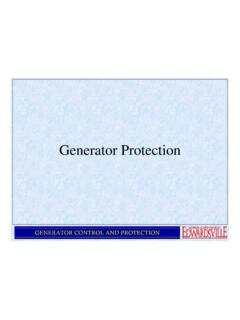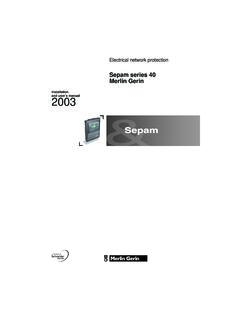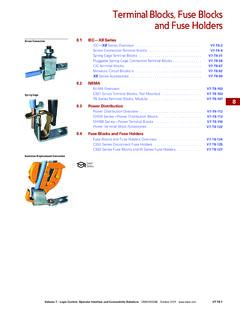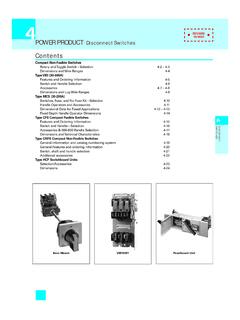Transcription of MiCOM P120/P121/P122/P123 - My Protection Guide
1 MiCOM P120/P121/P122/P123 Overcurrent Relays Version 10 Technical Guide P12X/EN T/H86 Technical Guide P12x/EN T/H86 Contents MiCOM P120/P121/P122/P123 Page 1/2 MiCOM P120/P121/P122 & P123 OVERCURRENT RELAYS TECHNICAL Guide CONTENTS Safety Instructions Pxxxx/EN SS/D11 Introduction P12x/EN IT/G86 Handling, Installation and Case Dimensions P12x/EN IN/G86 User Guide P12x/EN FT/G86 Menu Content Tables P12x/EN HI/G86 Technical Data and Curve Characteristics P12x/EN TD/H86 Application Guide P12x/EN AP/H86 Communication Database P12x/EN CT/G86 Commissioning and Maintenance Guide P12x/EN CM/G86 Connection Diagrams P12x/EN CO/G86 Commissioning Test and Setting Records Sheets P12x/EN RS/G86 Hardware/Software Version History and Compatibility NOT YET AVAILABLEP12x/EN T/H86 Technical Guide ContentsPage 2/2 MiCOM P120/P121/P122/P123 BLANK PAGE Pxxxx/EN SS/D11 Safety Section Page 1/8 STANDARD SAFETY STATEMENTS AND EXTERNAL LABEL INFORMATION FOR AREVA T&D EQUIPMENT 1.
2 INTRODUCTION 3 2. HEALTH AND SAFETY 3 3. SYMBOLS AND LABELS ON THE EQUIPMENT 4 Symbols 4 Labels 4 4. INSTALLING, COMMISSIONING AND SERVICING 5 5. DE-COMMISSIONING AND DISPOSAL 7 6. TECHNICAL SPECIFICATIONS FOR SAFETY 8 Protective fuse rating 8 Protective class 8 Installation category 8 Environment 8 Pxxxx/EN SS/D11 Page 2/8 Safety Section BLANK PAGE Pxxxx/EN SS/D11 Safety Section Page 3/8 1. INTRODUCTION This Safety Section and the relevant equipment documentation provide full information on safe handling, commissioning and testing of this equipment also includes reference to typical equipment label markings.
3 The technical data in this Safety Section is typical only, see the technical data section of the relevant equipment documentation for data specific to a particular equipment. Before carrying out any work on the equipment the user should be familiar with the contents of this Safety Section and the ratings on the equipment s rating label. Reference should be made to the external connection diagram before the equipment is installed, commissioned or serviced. Language specific, self-adhesive User Interface labels are provided in a bag for some equipment. 2. HEALTH AND SAFETY The information in the Safety Section of the equipment documentation is intended to ensure that equipment is properly installed and handled in order to maintain it in a safe condition. It is assumed that everyone who will be associated with the equipment will be familiar with the contents of this Safety Section, or the Safety Guide (SFTY/4L M).
4 When electrical equipment is in operation, dangerous voltages will be present in certain parts of the equipment. Failure to observe warning notices, incorrect use, or improper use may endanger personnel and equipment and cause personal injury or physical damage. Before working in the terminal strip area, the equipment must be isolated. Proper and safe operation of the equipment depends on appropriate shipping and handling, proper storage, installation and commissioning, and on careful operation, maintenance and servicing. For this reason only qualified personnel may work on or operate the equipment. Qualified personnel are individuals who: Are familiar with the installation, commissioning, and operation of the equipment and of the system to which it is being connected; Are able to safely perform switching operations in accordance with accepted safety engineering practices and are authorized to energize and de-energize equipment and to isolate, ground, and label it; Are trained in the care and use of safety apparatus in accordance with safety engineering practices; Are trained in emergency procedures (first aid).
5 The equipment documentation gives instructions for its installation, commissioning, and operation. However, the manuals cannot cover all conceivable circumstances or include detailed information on all topics. In the event of questions or specific problems, do not take any action without proper authorization. Contact the appropriate AREVA technical sales office and request the necessary information. Pxxxx/EN SS/D11 Page 4/8 Safety Section 3. SYMBOLS AND LABELS ON THE EQUIPMENT For safety reasons the following symbols which may be used on the equipment or referred to in the equipment documentation, should be understood before the equipment is installed or commissioned. Symbols Caution: refer to equipment documentation Caution: risk of electric shock Protective Conductor (*Earth) terminal Functional/Protective Conductor (*Earth) terminal Note: This symbol may also be used for a Protective Conductor (Earth) terminal if that terminal is part of a terminal block or sub-assembly power supply.
6 *NOTE: THE TERM EARTH USED THROUGHOUT THIS TECHNICAL MANUAL IS THE DIRECT EQUIVALENT OF THE NORTH AMERICAN TERM GROUND. Labels See Safety Guide (SFTY/4L M) for typical equipment labeling information. Pxxxx/EN SS/D11 Safety Section Page 5/8 4. INSTALLING, COMMISSIONING AND SERVICING Equipment connections Personnel undertaking installation, commissioning or servicing work for this equipment should be aware of the correct working procedures to ensure safety. The equipment documentation should be consulted before installing, commissioning, or servicing the equipment. Terminals exposed during installation, commissioning and maintenance may present a hazardous voltage unless the equipment is electrically isolated.
7 Any disassembly of the equipment may expose parts at hazardous voltage, also electronic parts may be damaged if suitable electrostatic voltage discharge (ESD) precautions are not taken. If there is unlocked access to the rear of the equipment, care should be taken by all personnel to avoid electric shock or energy hazards. Voltage and current connections should be made using insulated crimp terminations to ensure that terminal block insulation requirements are maintained for safety. Watchdog (self-monitoring) contacts are provided in numerical relays to indicate the health of the device. AREVA T&D strongly recommends that these contacts are hardwired into the substation's automation system, for alarm purposes. To ensure that wires are correctly terminated the correct crimp terminal and tool for the wire size should be used. The equipment must be connected in accordance with the appropriate connection diagram.
8 Protection Class I Equipment - Before energizing the equipment it must be earthed using the protective conductor terminal, if provided, or the appropriate termination of the supply plug in the case of plug connected equipment. - The protective conductor (earth) connection must not be removed since the Protection against electric shock provided by the equipment would be lost. - When the protective (earth) conductor terminal (PCT) is also used to terminate cable screens, etc., it is essential that the integrity of the protective (earth) conductor is checked after the addition or removal of such functional earth connections. For M4 stud PCTs the integrity of the protective (earth) connections should be ensured by use of a locknut or similar. The recommended minimum protective conductor (earth) wire size is mm ( mm for North America) unless otherwise stated in the technical data section of the equipment documentation, or otherwise required by local or country wiring regulations.
9 The protective conductor (earth) connection must be low-inductance and as short as possible. All connections to the equipment must have a defined potential. Connections that are pre-wired, but not used, should preferably be grounded when binary inputs and output relays are isolated. When binary inputs and output relays are connected to common potential, the pre-wired but unused connections should be connected to the common potential of the grouped connections. Before energizing the equipment, the following should be checked: - Voltage rating/polarity (rating label/equipment documentation); - CT circuit rating (rating label) and integrity of connections; - Protective fuse rating; - Integrity of the protective conductor (earth) connection (where applicable); - Voltage and current rating of external wiring, applicable to the application. Pxxxx/EN SS/D11 Page 6/8 Safety Section Accidental touching of exposed terminals If working in an area of restricted space, such as a cubicle, where there is a risk of electric shock due to accidental touching of terminals which do not comply with IP20 rating, then a suitable protective barrier should be provided.
10 Equipment Use If the equipment is used in a manner not specified by the manufacturer, the Protection provided by the equipment may be impaired. Removal of the equipment front panel/cover Removal of the equipment front panel/cover may expose hazardous live parts, which must not be touched until the electrical power is removed. UL and CSA listed or recognized equipment To maintain UL and CSA approvals the equipment should be installed using UL and/or CSA listed or recognized parts of the following type: connection cables, protective fuses/fuseholders or circuit breakers, insulation crimp terminals, and replacement internal battery, as specified in the equipment documentation. Equipment operating conditions The equipment should be operated within the specified electrical and environmental limits. Current transformer circuits Do not open the secondary circuit of a live CT since the high voltage produced may be lethal to personnel and could damage insulation.









